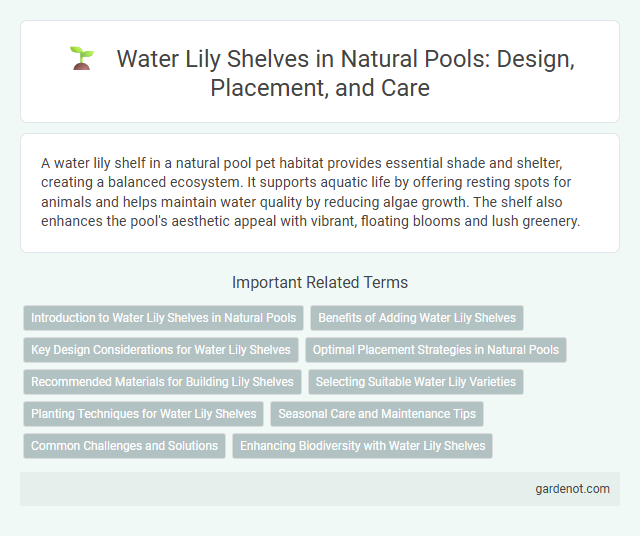A water lily shelf in a natural pool pet habitat provides essential shade and shelter, creating a balanced ecosystem. It supports aquatic life by offering resting spots for animals and helps maintain water quality by reducing algae growth. The shelf also enhances the pool's aesthetic appeal with vibrant, floating blooms and lush greenery.
Introduction to Water Lily Shelves in Natural Pools
Water lily shelves in natural pools create a shallow, nutrient-rich area that supports healthy aquatic plant growth while enhancing water quality. These shelves provide ideal conditions for water lilies to flourish, promoting oxygenation and habitat diversity. Integrating water lily shelves helps maintain ecological balance and aesthetic appeal in natural swimming environments.
Benefits of Adding Water Lily Shelves
Water lily shelves enhance natural pools by providing essential habitat for aquatic life, promoting biodiversity and ecological balance. They improve water quality through natural filtration and oxygenation, reducing algae growth and maintaining clear, healthy water. These shelves also offer aesthetic appeal, creating serene, visually pleasing environments that blend seamlessly with natural landscapes.
Key Design Considerations for Water Lily Shelves
Water lily shelves in natural pools require careful design to balance plant health and water quality, ensuring optimal sunlight exposure with a depth range of 10-30 cm to support lily root systems. The substrate must consist of nutrient-rich, well-drained soil to promote growth while preventing nutrient runoff that can disrupt pool ecology. Adequate spacing and integration with pool circulation systems are essential to prevent stagnant water zones and maintain biodiversity within the natural pool environment.
Optimal Placement Strategies in Natural Pools
Water lily shelves in natural pools should be positioned in shallow areas receiving 4 to 6 hours of direct sunlight daily to maximize photosynthesis and flowering. Placing these shelves at depths between 15 to 30 cm ensures optimal root anchorage while allowing leaves to float on the surface, enhancing water oxygenation and providing shade to minimize algae growth. Strategic placement near pool edges promotes biodiversity by creating microhabitats for aquatic insects and amphibians, contributing to the ecological balance of the natural pool system.
Recommended Materials for Building Lily Shelves
Recommended materials for building a water lily shelf in a natural pool include untreated cedar or redwood for their natural resistance to water and decay, ensuring longevity without harmful chemicals. Using marine-grade plywood provides a sturdy, moisture-resistant base that supports lily growth while maintaining pool aesthetics. Incorporating natural stone or slate can enhance stability and blend seamlessly with the natural pool environment, promoting healthy aquatic ecosystems.
Selecting Suitable Water Lily Varieties
Selecting suitable water lily varieties for a natural pool involves considering factors such as climate zone, sunlight exposure, and water depth to ensure optimal growth and bloom. Hardy water lilies, like Nymphaea odorata, thrive in temperate regions and tolerate colder temperatures, while tropical varieties require warmer conditions and consistent water temperatures above 70degF. Additionally, choosing dwarf or miniature water lilies can be ideal for smaller pools or shallow water lily shelves to maintain balanced aquatic ecosystems.
Planting Techniques for Water Lily Shelves
Water lily shelves should be planted using nutrient-rich aquatic soil placed in wide, shallow containers to support root growth while allowing proper water flow. Positioning the shelves at depths between 15 to 30 centimeters optimizes sunlight exposure essential for photosynthesis and blooming. Regularly dividing and repotting water lilies every 2 to 3 years prevents overcrowding and promotes healthy growth within the natural pool ecosystem.
Seasonal Care and Maintenance Tips
Water lily shelves in natural pools require seasonal care to maintain healthy growth and vibrant blooms. During spring, trim dead leaves and thin out crowded plants to promote circulation and prevent algae buildup. In fall, reduce feeding and remove decaying foliage to prepare the plants for dormancy and ensure a clean, balanced aquatic environment.
Common Challenges and Solutions
The water lily shelf in natural pools often faces challenges like algae overgrowth and insufficient sunlight penetration, which can hinder lily growth and water clarity. Implementing regular maintenance such as controlled pruning, using aquatic-compatible algae treatments, and ensuring proper shelf depth can significantly improve plant health and ecosystem balance. Enhancing water circulation around the shelf also prevents stagnant conditions, promoting a thriving aquatic environment.
Enhancing Biodiversity with Water Lily Shelves
Water lily shelves create diverse microhabitats in natural pools, supporting aquatic insects, amphibians, and beneficial microorganisms. These shelves provide shade and oxygenation, which help regulate water temperature and quality, fostering a balanced ecosystem. Incorporating water lily shelves promotes natural filtration and attracts pollinators, enhancing overall biodiversity in the aquatic environment.
Water lily shelf Infographic

 gardenot.com
gardenot.com